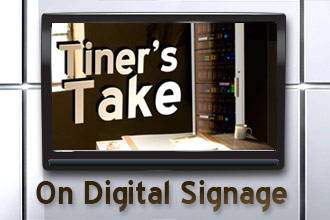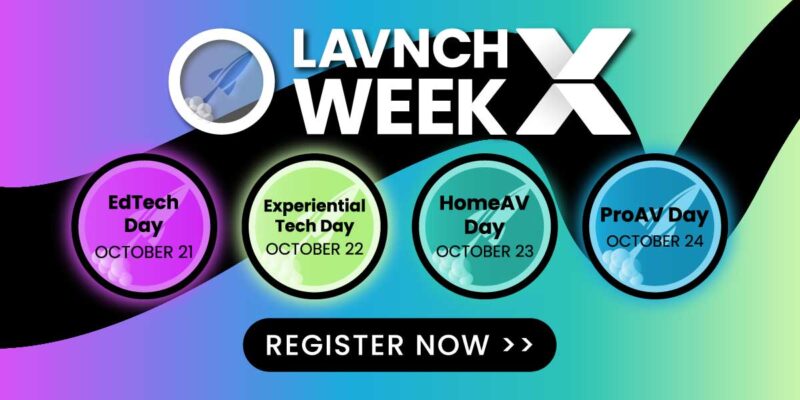Tiner Takes on Digital Signage
 I am excited to have been given the opportunity to think about and write about digital signage in education for rAVe [Publications]. I have scratched the surface on this topic previously, in my March rAVe ED column. In that column I addressed some of the differences between the educational market and the commercial market with digital signage. The very clear line between the two markets is whether we are trying to generate income. Much of the content in an academic environment is not designed to generate income, yet to say that we don’t have the ability to generate content with signage is a mistake. Also, we do need to think more about ROI (return on investment) and TCO (total cost of ownership) for those times when our signage is informational, rather than used to generate money. These are both topics I will address in future columns, and topics that integrators, manufacturers and even advertising companies can help us with.
I am excited to have been given the opportunity to think about and write about digital signage in education for rAVe [Publications]. I have scratched the surface on this topic previously, in my March rAVe ED column. In that column I addressed some of the differences between the educational market and the commercial market with digital signage. The very clear line between the two markets is whether we are trying to generate income. Much of the content in an academic environment is not designed to generate income, yet to say that we don’t have the ability to generate content with signage is a mistake. Also, we do need to think more about ROI (return on investment) and TCO (total cost of ownership) for those times when our signage is informational, rather than used to generate money. These are both topics I will address in future columns, and topics that integrators, manufacturers and even advertising companies can help us with.
Beyond the monetary aspects of digital signage, the education market has some unique requirements and needs. We may have administrative assistants, faculty members and senior administrators, all who want and need to update the information on the signage. We may have marketing or media relations department who can coordinate this, or we may not. Believe it or not, some of us may have SEVERAL media relations and marketing, or SEVERAL IT/AV departments who are deploying and supporting this technology on one campus. How do we as technology managers handle all these people and the training and support that goes along with it? How does a good integrator find ways to sell us products and SERVICES that help blend all these different people and departments together?
Our security departments are very interested in this technology, even if they hope they never need to use it. Many of our campuses (hopefully all!) have developed emergency response teams that meet regularly to discuss how to react to campus emergencies. This does not just include immediate violence on the campus, it may include outbreaks of viruses, disease or more timely, dangerous weather. This emergency response team has a stake in the digital signage on your campus and needs to be part of the decision making process, design process and most importantly be aware of how to access the signs during an emergency.
We can not forget our admissions teams. These are the people who attract the best and the brightest to our campus. They are the ones who put the best face on our campuses for visitors who are interested in applying. They may be interested in wayfinding, as well as digital signage that tells stories using audio and video, making sure that the visitors get a taste of everyday life on our campuses. As a technology manager, we need to be up to date on all the latest digital signage technology to give our admissions teams a leg forward. We need our partners in manufacturing and integration to help us with education and training.
There are so many other uses for digital signage in an academic institution. In higher ed, we have athletics, special events, people who rent space on our campus, dining services, bookstores and dozens of other groups and departments who may be interested in, and find value in, digital signage.
Let’s not forget the K-12 market as well. These are kids who know nothing other than technology and video screens. We can sit back and lament this fact, or we can take it at face value and meet those students where they are. We need to be very thoughtful in thinking about how digital signage could be applied to K-12, because their budgets and time are extremely tight. Anything that can be seen as a luxury or as more work will be dead on arrival. Yet, we know that K-12 markets put money into technology if it has a clear effect on student outcomes. We also know that schools have put (rightfully so) a large amount of money in securing their buildings. Communication and outreach to parents and the community is a major part of K-12 education, and something most districts continually struggle with. So if you have the right product, and sell it with the right marketing points, there is money available.
I hope to write on a regular basis about ways that we can incorporate digital signage into educational settings. As a technology manager, local school board member, trained teacher and parent of middle school and elementary school children, I have a lot of exposure to schools! I will expand on the several ideas I mentioned above and delve deeper into other issues as well. Whether you are an integrator, trying to understand how to break into this market, an educator trying to decide how and if this could work for you, or an owner wondering what you have got yourself into, this new column will be for you. As with all my columns, your feedback, thoughts and comments are invaluable. I look forward to hearing from you.
Reach Scott Tiner at stiner08@gmail.com, or on LinkedIn and Twitter.





